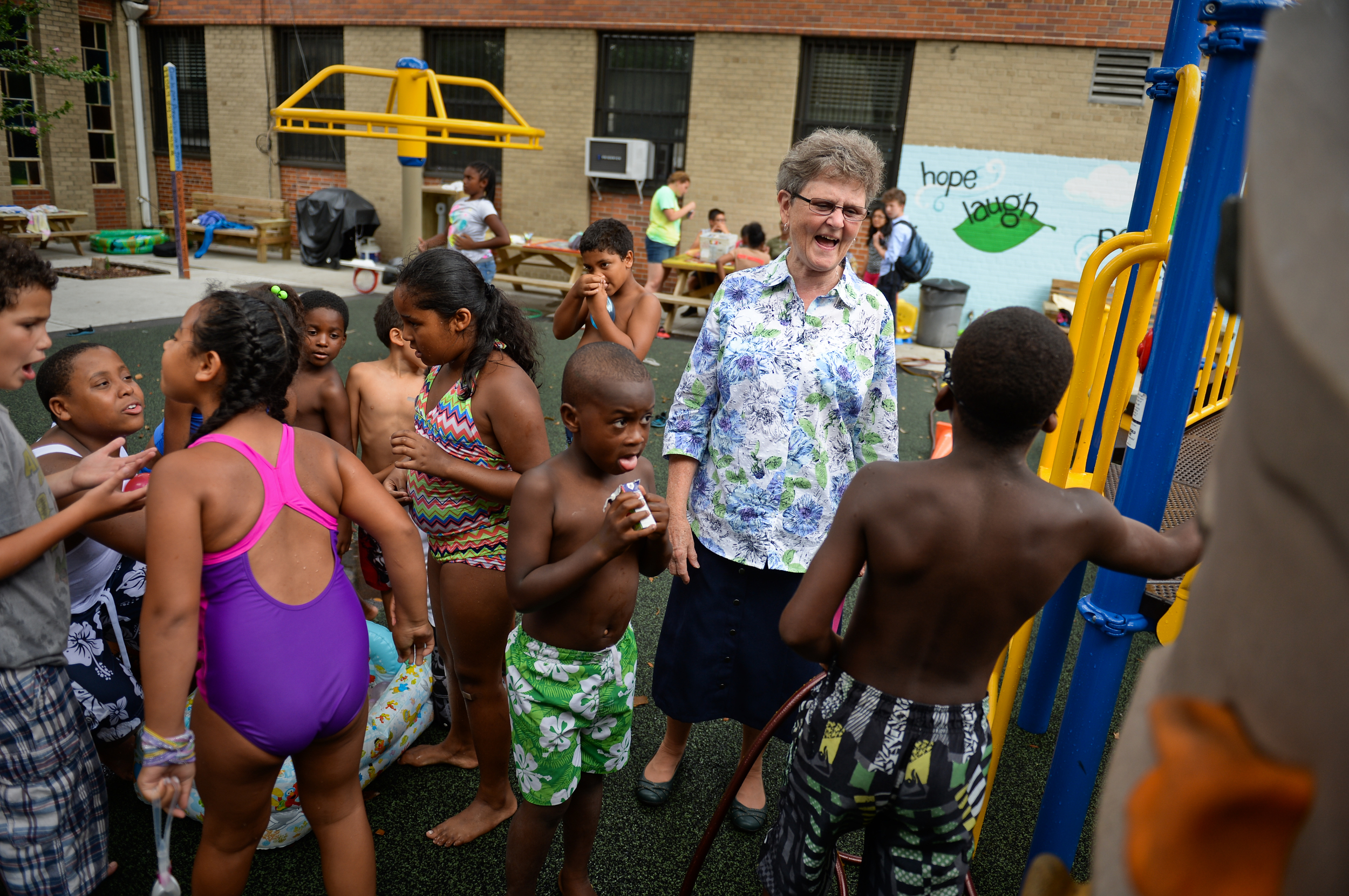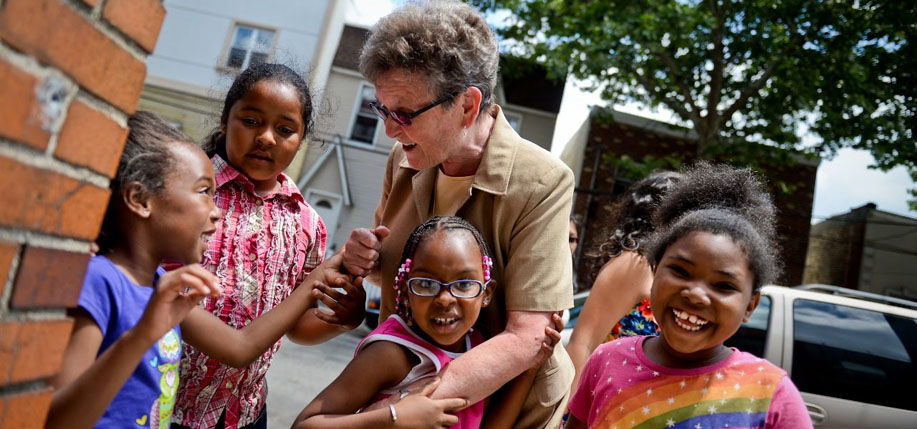Sister Teresa “Tesa” Fitzgerald, a nun of the order of the Sisters of St. Joseph and the founder of non-profit organization Hour Children, is a long-time believer in the power of routine. “If you can embrace it,” she says, “you can run with it.” Stepping through the doors of Hour Children’s central facility, it’s easy to see why she holds this view so firmly – the place, abuzz with activity, runs like clockwork. The staff, gregarious and efficient, are busy preparing cans for an upcoming food drive and quick to greet visitors with a smile. Even Sr. Tesa’s much-loved cats fit seamlessly into the center’s rhythm, affectionate and constantly in motion. The walls are hidden beneath countless framed photographs and decorative pieces; hanging near the entrance, one brightly-colored sign draws the eye. It reads, “A mother holds her child’s hand for a while and their heart forever.”
Based out of Long Island City, Queens, Hour Children takes its name from the critical hours that govern the relationship between an incarcerated mother and her child – the hour of incarceration, visitation hours during the prison term, and the hopeful, often intimidating, hour of the woman’s release and reunification with her family. Sr. Tesa founded the organization in 1986, when it initially brought care to the children of women in Bedford Hills and Taconic Correctional Facilities on Long Island. Now, the organization’s services are composed of both prison and community-based support programs like case management and therapeutic services, adult mentoring, vocational training, and child day care and teen group facilities, as well internship opportunities at the organization’s community food pantry, three thrift shops, and employment office. Apartment housing is currently available up to 75 families at a time, with expansion not far off the horizon. In 2014, Sr. Tesa received the prestigious Opus Prize, a $1 million award for those who inspire and promote humanitarian and social work, which she pledged to invest in additional housing for Hour Children.
With a U.S. prison population composed overwhelmingly of male offenders, incarcerated women are frequently reduced to a shadowed demographic. Of the 58 prisons in New York State alone, a mere three are used for the detainment of females. Working first with non-profit group Providence House in the 1980s, Sr. Tesa paid visits to New York’s women’s prisons, listening to the stories as the inmates were prepared to tell them. During this time, she became aware of the outcast status of formerly-incarcerated women, their pain, and the very real possibility of homelessness that awaited them upon being freed.
“There is a need to specialize,” she says. “When you specialize in something, you become a little more savvy about it. You can advocate for people. You learn. You can become the spokesperson for a population that doesn’t have a voice.” Translating the cries of the silent, Sr. Tesa soon realized the need to help keep the mother-child bond strong during this time of divide. In order to do so, she wasted no time in becoming a licensed foster mother.

“You have one woman’s jail, Rose M. Singer [on Riker’s Island],” she says. “There are 600 to 700 women there. When I go into a woman’s prison, it’s like an oasis. They’re so filled with grief and regret and remorse, but there’s also a sense of hope there. They’re so open and honest and willing to talk, much more than I would have been, to talk about their life stories and where they went wrong. They own their mistakes. How many of us own our mistakes?”
To say that Hour Children offers these women a second chance would be inaccurate, says Sr. Tesa, who is lightning-quick to explain that many ex-offenders never had a first chance to begin with. “The women I’ve met over the last 30 years in doing this, they didn’t have a family network of support. As a result, their early lives were in chaos. They lived in poverty, whether it was physical, emotional, or spiritual, and as a result, they sought life in negative ways. Drugs looked good, drinking looked good, men looked good. The streets drew them. When they come to us, whether they come with a child or as a single woman, we provide a community.” The recidivism rate for women who become involved with Hour Children is just 3.5 percent.
The model Hour Children supplies is as diverse as it is welcoming, encompassing both mothers and childless women, the young and the old, first-time offenders and those who have served multiple sentences, people of all races and religions willing to work towards future fulfilment for themselves and their loved ones.
Sr. Tesa’s appreciation for life’s stable dependabilities are shared by many of the women Hour Children strives to help establish a life – if not at first, then often after some exposure to her philosophies. “People can grow into a sense of sharing – it’s expected that you’re going to contribute your time, your talent, and your resources to our community in the house. You’re going to help cook, you’re going to help clean, and, at night, you’re going to come together in the kitchen – the hearth, which is so Irish, when you get down to it. You sit around with a cup of tea after the kids go to bed, and you talk. You share your experiences of the day, and you look for advice; and if you don’t look for it, you’re going to get it!”
The internalization of such routine, she believes, is essential for personal growth. “I know that if I have to get up early in the morning, I have to go to bed at a certain time. I have to have things ready. That’s learning. Structure becomes an ally rather than an enemy.”

In a 1950s Irish Catholic cul-de-sac of the Hewlett hamlet in Nassau County, New York, the Fitzgerald family were certainly no strangers to the importance of structure. It gave pattern to their otherwise simple lives. Tesa’s father John was a gardener from Lative, County Kerry, and her mother Catherine was a maid from County Donegal. Young Tesa and her three siblings slept in a fold-out bed on the porch of their tiny bungalow. Her parents made clear what was really important.
“My father, he would get up and go to 6:30 mass every Sunday morning,” Sr. Tesa recalls. “He had just one suit, and it was always the same shirt. He’d go by himself to the 6:30, come home, and get us all up. He had a truck, an old black truck, and he would clean it out on Saturday night, get all the machinery out of the back of it, and then put these two boards in the back. That’s where we’d sit while he’d drive us to church. He’d drop us off, and we’d walk home, but that was his way of getting us there.”
Like so many other Irish migrants, John and Catherine, who met in the U.S., put every cent they earned into broadening their children’s future horizons, giving them a Catholic education, and supporting those still living across the ocean. To receive a transatlantic letter, she explains, was the closest thing they had to real interaction with those back in Ireland. “A letter would come, my mother would read the letter, and then call my aunt and read her the letter. By the time it was all over, the thing was just worn. It was something from home.”
However, there was no letter long enough that could substitute a real presence, as Tesa learned the night they received word of her grandmother’s death in Donegal. “A phone call came in from my aunt,” she says. “My mother cried. Later on in life, I kept thinking, to get that call and not be present for that… It was awful.”
Despite contending with the difficulties laid upon all diaspora Irish, Catherine worked tirelessly to provide her children with the resources they would need for an auspicious future. Sr. Tesa remembers she often saw her in a black dress and white apron, knowing nothing of it being a housemaid’s uniform, thinking only that her mother looked beautiful.

With the unshakeable love of a mother-child connection inspiring the constant forward momentum of Hour Children’s work, success stories are bountiful. An experience particularly close to Sr. Tesa’s heart is that which she shared with Julia, the daughter of a teenage girl wrongly incarcerated during the New York drug raids in the 1980s. After the death of her maternal grandparents, Julia became one of Sr. Tesa’s first foster children. She would leap at any chance to attend visitation hours, “sitting in the back seat and talking to her imaginary friends about what the visit was going to be like, what her mother would be wearing, what color lipstick she would have on,” she says.
“Then, to watch them in the visiting room, it was like… oh my God, everything just faded away but the two of them. Julia was the center of this woman’s life. We helped advocate for clemency for her mother, and when Julia was nine, her mother was freed. We were outside. They went off to live together, and Julia went to college. Her mother did well, working in real estate.”
Little Julia, Sr. Tesa says, was her earliest teacher in this 30-year study of the importance of maintaining the closeness of mother and child through all stages of incarceration. Through her, she learned that it really is the small things that count the most. “All the little ways they did it… she would get something ready in her room, and say, ‘My mother needs to see this, can you take a picture?’ So I took pictures of everything. It’s important, because it’s the little things in life that are meaningful. When things get tough, you need something of substance to hold on to.”
The effects of Hour Children upon the lives of the families it reaches are manifold – loving relationships are not only saved, strengthened, mended, and recreated, but every day, new ones are forged in ways even Sr. Tesa cannot predict.
“When Christmas came this year, it was amazing in my house,” she says. “Typically, we provide gifts, Santa comes, all of that. But this particular group of people bought for each other. They bought for me. They bought for the other sister who lives with us. It was just such a wonderful, real experience. And it wasn’t about the stuff, it was about the experience.”
The fact that Sr. Tesa has made her own home in the Astoria Hour Children housing facility should come as no surprise. For her, Hour Children is no mere project, but a way of life and a calling to represent a population so often left out in the cold.
Embedding herself in the daily rituals of it all has allowed Sr. Tesa to transform Hour Children into that which it strives to inspire – a close-knit family.
“I never thought I’d say this 30 years ago, but there’s a sense of pride for [the families] in being part of this. When you say that you’re with Hour Children, you immediately make it so that people know where you’ve come from, but it doesn’t matter any more. They’ve crossed that bridge. They’re owning their history; no one denies it. But it’s in the past. And here they are, building their futures.” ♦
_______________
Olivia O’Mahony is Irish America’s editorial assistant and copyeditor. Born in New York and raised in Lucan, County Dublin, she holds an international degree in English literature and anthropology from Maynooth University. She currently lives in Manhattan.


I personally know Tesa & am so happy for this recognition of her & of her work. I can’t see a more deserving person.
Awesome work she is doing. Thank you for recognizing her efforts.